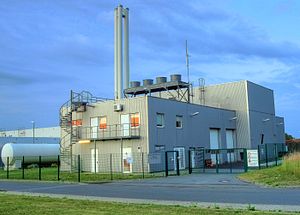Biomass cogeneration plant Werl
| Biomass cogeneration plant Werl | |||
|---|---|---|---|
| Biomass cogeneration plant Werl - Zunftweg entrance | |||
| location | |||
|
|
|||
| Coordinates | 51 ° 34 '3 " N , 7 ° 55' 7" E | ||
| country |
|
||
| Data | |||
| Type | Thermal power station | ||
| Primary energy | Biomass , fossil energy | ||
| fuel | Wood chips , natural gas , light heating oil | ||
| power | 0.5 megawatts of electricity, 12.3 megawatts of district heating |
||
| operator | STEAG New Energies GmbH | ||
| Start of operations | 2003 | ||
| turbine | Back pressure - steam turbine | ||
| boiler | Smoke tube boiler | ||
| Energy fed in per year | 3000 MWh electrical 15000 MWh district heating GWh |
||
| Website | www.evonik.com/newenergies? | ||
The Werl biomass cogeneration plant is a biomass-fired cogeneration plant in the KonWerl commercial and residential area in the north of the North Rhine-Westphalian city of Werl .
operator
The heating power plant is operated by STEAG New Energies GmbH, the former operator was Evonik New Energies GmbH.
history
The symbolic groundbreaking ceremony for the plant was on April 17, 2002. The feed into the district heating network began in mid-November 2002 and the feed into the power grid on December 19, 2002. Official commissioning was finally on May 23, 2003, since then the thermal power station has been generating electrical energy and district heating for private use - and commercial customers. A total of around 8.5 million euros was invested. Today three people work in the thermal power station.
technology
A high-pressure superheated steam boiler system with a combustion output of 4.5 megawatts (MW) five tons of steam per hour at a temperature of 380 ° C. This steam is used to heat production and the supply of a back pressure - steam turbine to generate electricity. The turbine system has an electrical connected load of 0.5 MW. The electricity generated is fed into the Werl municipal utility network. A maximum output of 3.3 MW is delivered to the 7.5 km long district heating network via a heating condenser. The total fuel efficiency is over 80%.
The biomass cogeneration plant was originally planned and built to burn old and residual wood. Since 2006, however, wood chips from forest and forestry have been used as fuel . In addition, green cuttings made from landscape conservation wood are also used. These fuels fall under the category of renewable raw materials (Nawaro) and therefore the electricity generated in the thermal power station is remunerated in accordance with the Renewable Energy Sources Act (EEG). The throughput of biomass fuel is 1.3 t / h, so a total of around 10,000 t of renewable resources are burned each year. Two fuel bunkers with a total volume of 280 m³ are available for storage.
In order to cover medium and peak loads for the district heating supply, two hot water boilers, each fired with natural gas or light heating oil, with an output of 4.5 MW each, were installed.
An annual energy output of approx. 3000 MWh electricity and approx. 15000 MWh district heating is planned.
Environmental and climate impacts
According to the former operator Evonik, the combined heat and power plant saves 5200 t of carbon dioxide annually.
Web links
Individual evidence
- ↑ a b c d e f g h i j k l m n o p q r s t u v w The Werl biomass thermal power station. (PDF, 900 kB) (No longer available online.) STEAG New Energies GmbH, January 2012, formerly in the original ; accessed on February 28, 2014 . ( Page no longer available , search in web archives ) Info: The link was automatically marked as defective. Please check the link according to the instructions and then remove this notice.
- ↑ A new biomass cogeneration plant is being built in the Westphalian town of Werl. EnergieAgentur.NRW, April 24, 2002, accessed on November 5, 2011 .

